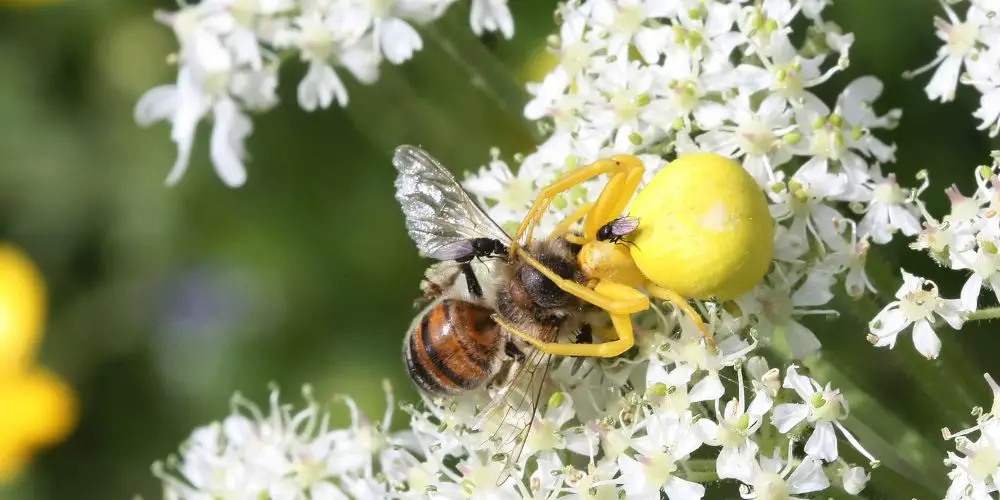Last updated on January 17th, 2024 at 01:49 pm
Bees are essential pollinators that play a crucial role in maintaining our ecosystem’s balance, but they aren’t free from danger.
Unfortunately, these fuzzy flyers are also a favourite food of many predatory insects.
From wasps and hornets to praying mantises and spiders, these creatures may not be bees’ best friends, but they’re fascinating in their own right. Let’s dive in!
*Warning – In this article, we’ll discuss exactly how other insects hunt, kill and consume bees and some of the descriptions may be upsetting to some.
What Insects Kill Bees?
Let’s take a quick look at the usual suspects when it comes to devouring our favourite buzzing friends.
- Wasps: Various species of wasps, including yellow jackets and paper wasps, are known to prey on bees. They usually hunt for bees near their nests and can be particularly aggressive in their pursuit.
- Hornets: Hornets are a type of wasp that’s much larger and more formidable than their smaller relatives. They hunt bees for food, especially during the late summer months.
- Ants: Some species of ants are known to prey on bees. They can attack a hive and take over, consuming the bees and their larvae.
- Spiders: Crab spiders and jumping spiders are known to feed on bees. They usually wait for bees to visit flowers before striking.
- Praying mantises: These giant insects are known for their predatory behaviour and are not shy about hunting bees.
- Robber flies: These flies are predators that hunt a variety of insects, including bees. They are often found near flowers and vegetation, waiting for their next meal to buzz by.
- Dragonflies: Although dragonflies are typically known for their diet of smaller insects such as mosquitoes, they have been known to catch and eat bees.
Do Wasps Eat Bees?
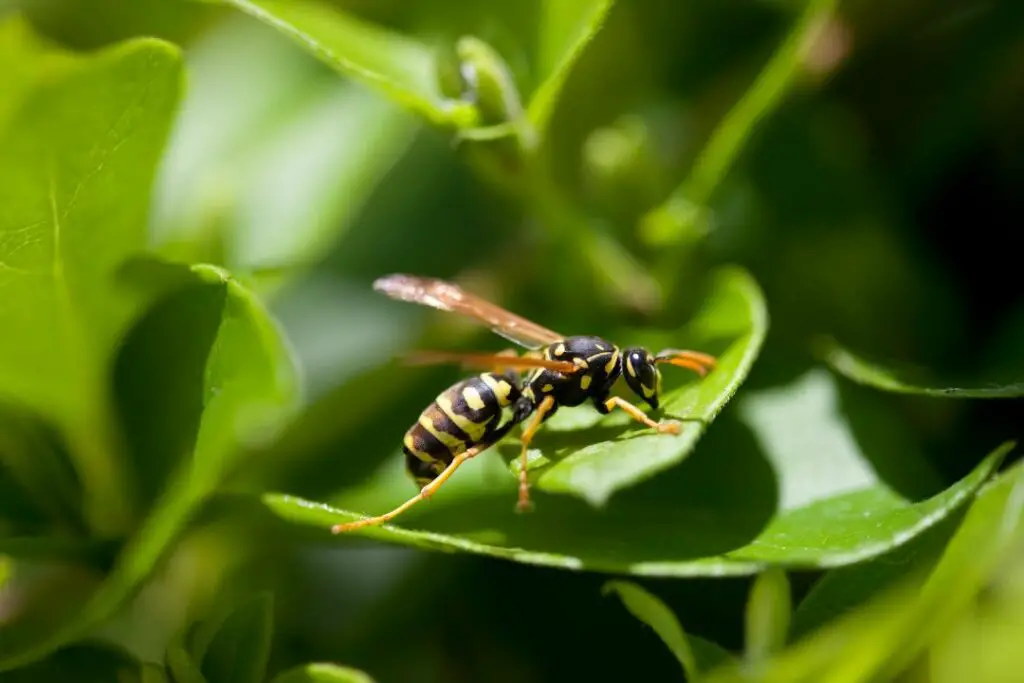
Wasps are bee predators found buzzing around flowers and gardens. While they’re best known for their painful stings, they’re also expert hunters who prey on a variety of other insects, including bees.
The most common species that hunt bees include yellow jackets, paper wasps, and hornets (more on them later). These insects typically have bright yellow and black stripes and a slender-waisted appearance that sets them apart from other flying insects.
Wasps hunt and eat bees by locating bee nests and hives. Once they find a colony, wasps will patrol the entrance, waiting for an unsuspecting bee to exit or enter.
When a bee comes within range, the wasp will swoop in and grab it with its powerful mandibles. It uses its stinger to subdue the bee, injecting it with venom that paralyzes the bee and makes it easier to handle.
Wasps are known for their aggressive hunting behaviour and they’ll often attack bees in groups, swarming and overwhelming them with their numbers.
Wasps don’t just eat bees for their sustenance – they also use them as food for their larvae.
Disgusting fact – Female wasps will lay their eggs on top of the paralyzed bees, and when the eggs hatch, the wasp larvae will feed on the bee’s body, consuming it from the inside out not unlike a horror movie!
These predatory insects play an important role in keeping other insect populations in check so the next time you see a wasp buzzing around, take a moment to appreciate its hunting prowess – just be sure to keep a safe distance!
Do Hornets Eat Bees?
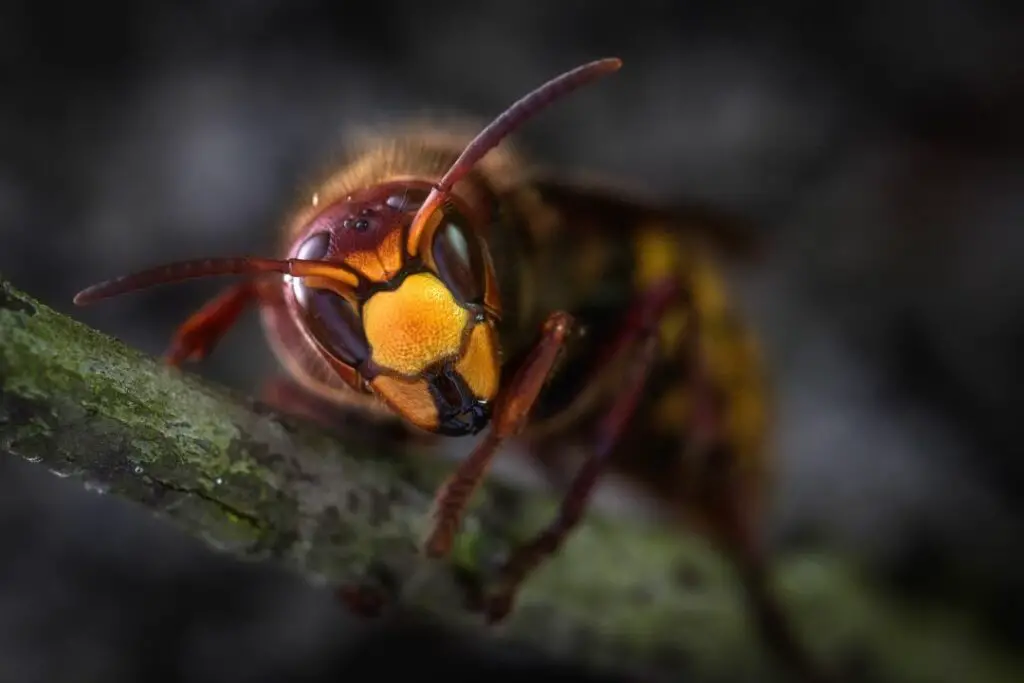
Think of Hornets as the terrifying larger versions of smaller wasp species. They can grow up to two inches in length, making them much larger than the average wasp.
Like other predatory wasps, hornets are attracted to the sweet scent of nectar and can often be found around flowers and gardens.
They are also known to hunt for bees near their hives, often attacking in groups to overwhelm their prey. Hornets are particularly aggressive in their pursuit of bees, and they are not shy about entering a hive to capture their prey.
Hornets hunt and kill bees by using their powerful mandibles and stingers. When a hornet spots a bee, it will swoop in and grab the bee with its mandibles which are strong enough to decapitate the bee or crush its exoskeleton.
Once the bee has been immobilized or killed the hornet will carry it back to its own nest, where it will be fed to the hornet larvae for its nutritious tissues and organs.
Interestingly, hornets have been observed using a variety of different techniques to hunt bees. Some hornets will hover near a hive entrance, while others lurk near flowers, attacking bees as they gather nectar.
Interesting fact – Buddha bees have developed a fascinating defence system against the dreaded Japanese Hornet. Check out the video below to see it in action.
In summary, hornets are powerful predators that play an important role in the ecosystem. While they may be a threat to bees, they are fascinating creatures in their own right and an apex predator in most gardens.
Do Ants Eat Bees?
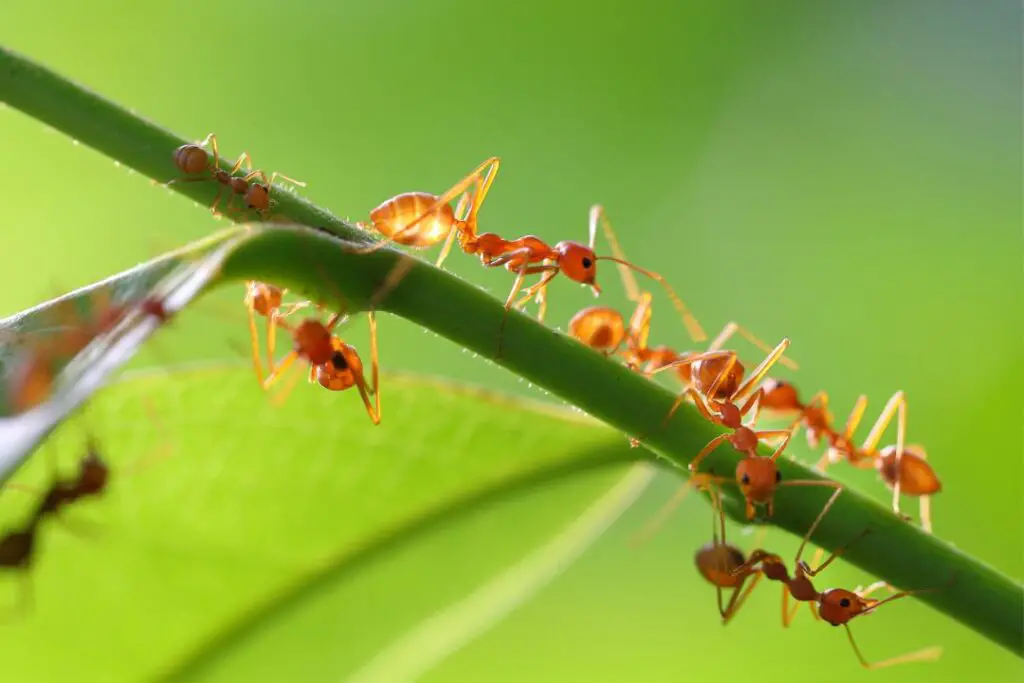
Ants are known for their industrious behaviour, working together to achieve common goals. While they may seem like harmless insects, some species of ants are actually skilled predators that can hunt and consume other insects.
One of the key ways that ants hunt and eat bees is by locating the bee’s nest or hive. Once they have found a colony, the ants will enter the hive from the ground level.
Many beekeepers will place the legs f their hive in small pots of water to create a barrier and stop ants from invading.
If/when they reach the hive or nest ants rely on a combination of sheer numbers and powerful jaws to overpower and carry back any bees they come across.
While ants may not be as well-known for their predatory behaviour as wasps and hornets, they are still an important part of the ecosystem.
Do spiders eat bees?
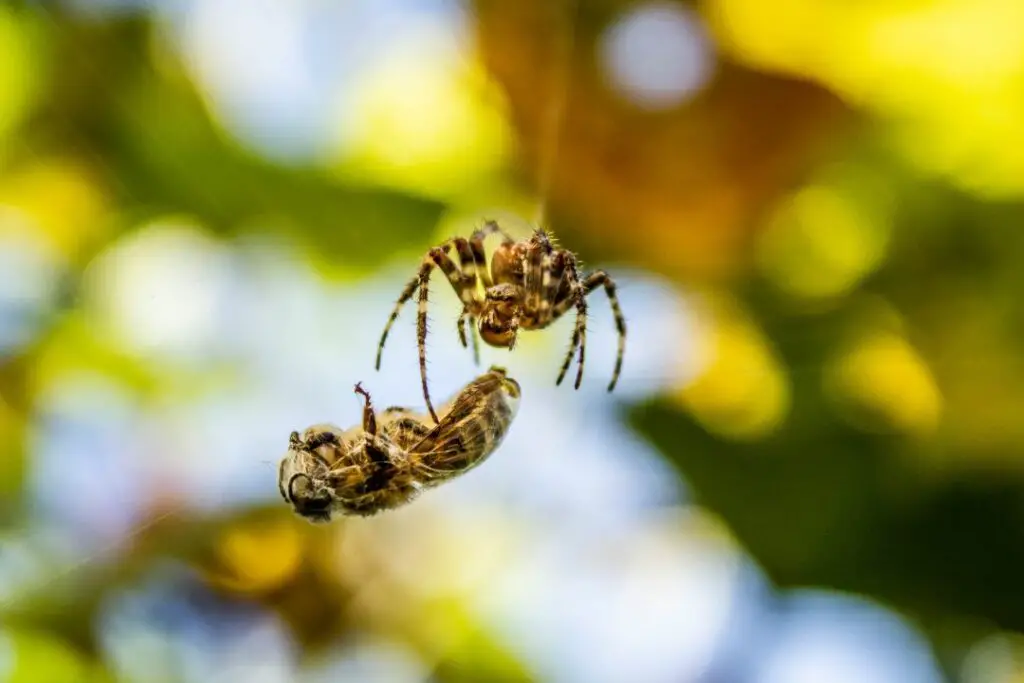
Spiders are well-known for their ability to spin webs and catch prey, and their stealthy hunting techniques make them a formidable foe for bees.
Most spiders hunt bees by building webs near flowers or busy flight paths. When a bee gets caught in the web, the spider pounces to capture its prey.
Some spiders use their venom to subdue the bee, while others wrap it up in silk to prevent it from escaping.
Once the bee is immobile, the spider will feed on its body, consuming its nutritious tissues, bodily fluids and organs. Some will consume the entire bee, while others are a bit picky, only eating certain body parts, like the abdomen or head.
Hunting spiders have been observed waiting outside the hive in an ambush. This hunting technique requires a great deal of stealth and patience, which is a testament to their impressive hunting abilities.
*Additional reading – Head over to our guide on which spiders kill and eat bees.
do praying mantis eat bees?
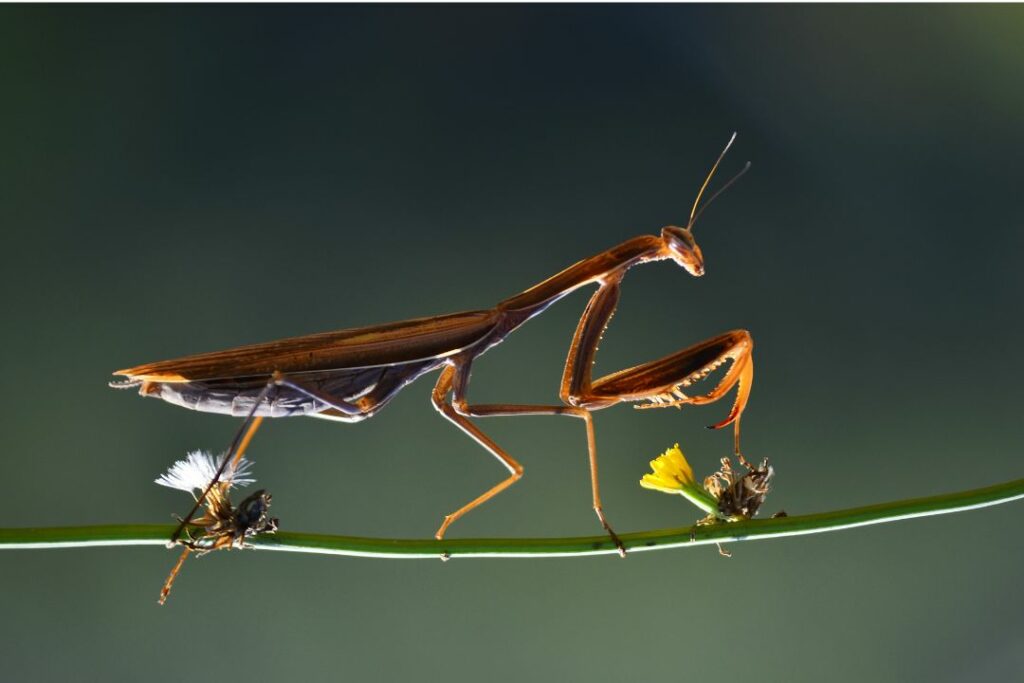
I don’t think bees can feel fear, but if they feared any insect on this list, it would be the Praying Mantis, without a doubt.
Praying mantises are known for their distinctive appearance and their impressive hunting skills. These insects have long, slender bodies and powerful front legs that they use to catch and subdue their prey.
They’re best known for eating other insects, but they’ll switch to a bee predator if they happen to cross paths.
Once the bee has been caught, the praying mantis will use its sharp front legs to hold onto it and prevent it from escaping.
Unlike other insects, the Mantis won’t wait to use its powerful jaws to bite into the bee’s exoskeleton and will happily consume it while it’s still alive.
And it’s not just bees that are at risk. Mantis practice “sexual cannibalism”, meaning the female praying mantis will actually eat the male after mating.
While this may seem like a gruesome behaviour, it is thought to provide the female with additional nutrition that can help her produce more eggs.
Do Robber Flies Eat Bees?
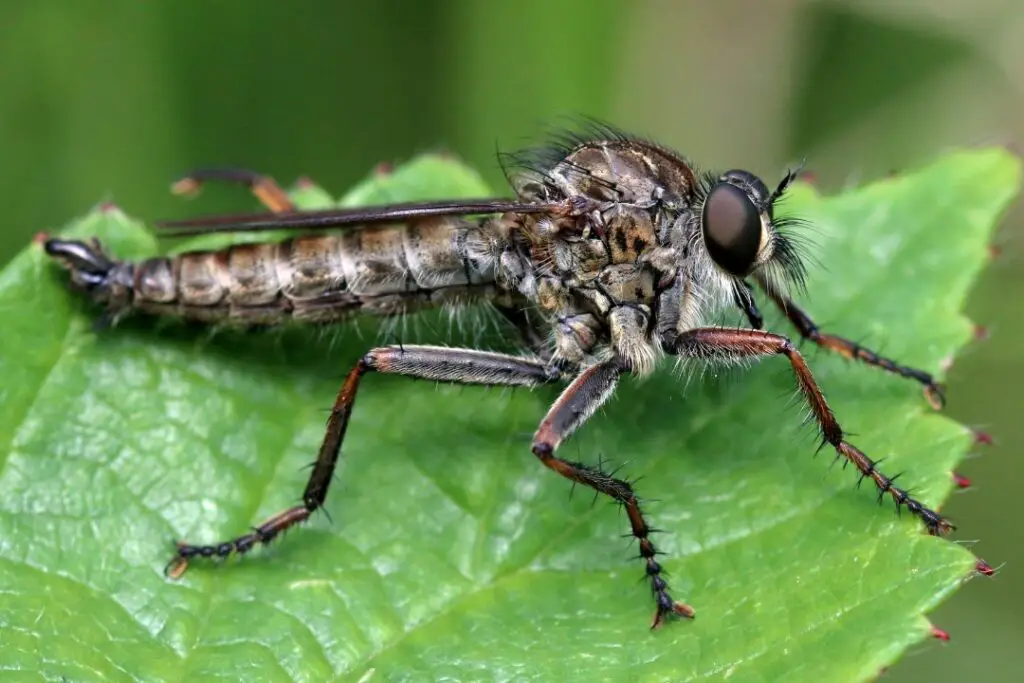
Robber flies, also known as assassin flies, are a type of fly known for their agile hunting skills. They have long, slender bodies and mighty wings, allowing them to fly quickly and catch prey mid-air.
Robber flies have a variety of methods for hunting bees. Some species simply wait on a perch or hover near flowers and then attack bees when they come into range.
Others are more active hunters, chasing bees through the air and using their powerful legs to catch and immobilize their prey.
Once the bee has been caught, the robber fly will use its sharp, piercing mouthparts to inject saliva into the bee’s body. This saliva contains enzymes that break down the bee’s tissues and allow the robber fly to consume its nutritious body fluids.
Interestingly, some species of robber flies have evolved a unique hunting strategy known as “mimicry.” These flies have markings on their bodies that make them look like bees or wasps, allowing them to get close to their prey without being detected.
Do Dragonflies Eat Bees?
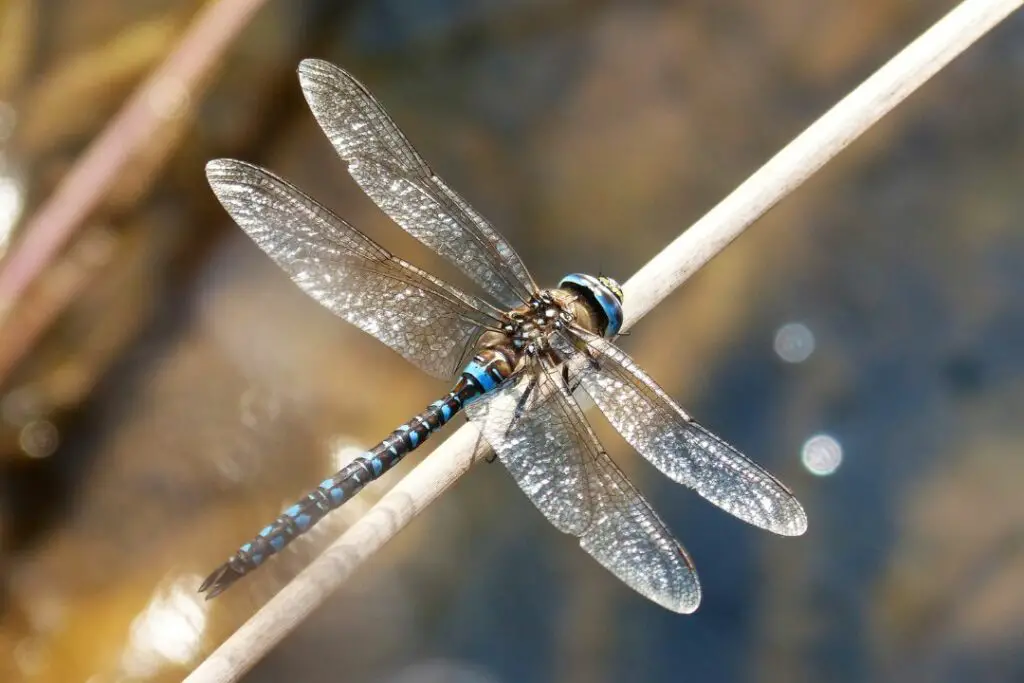
Dragonflies are known for their aerial acrobatics and impressive hunting skills. They have long, slender bodies and powerful wings that allow them to fly quickly and catch prey in mid-air.
It’s not overly common to see Dragonflies predating bees, but it can and will happen particularly if a bee wanders into a dragonfly’s territory.
They patrol specific areas like ponds and streams, and their impressive eyesight allows them to track and catch prey with incredible accuracy.
Interesting fact – Some species of dragonflies can see objects moving up to 30 feet away, making them highly effective hunters.
Dragonflies are aerial predators that can hunt and eat bees with ease. While they may not be as well-known as other predators on this list, they will still attack and kill bees if given the chance.
Conclusion
From wasps to dragonflies, these predators have developed various strategies for hunting and consuming bees.
While it may be tempting to view these insects as “pests” that need to be eliminated from our gardens, it’s important to remember that they are all part of the delicate balance of nature. Many of these predatory insects are essential pollinators in their own right.
By understanding the complex relationships between insects in your garden, you can create a healthy and sustainable ecosystem that benefits all its inhabitants, including bees and predators.

